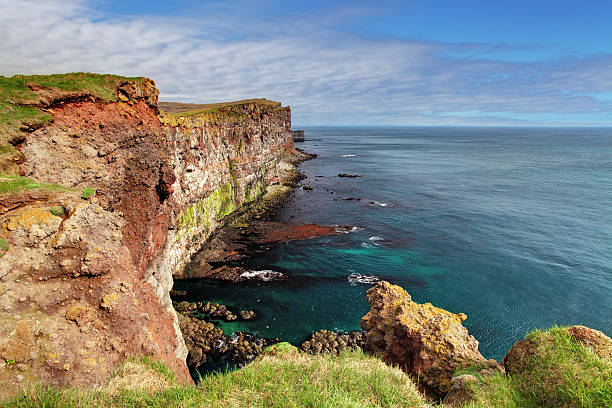Wednesday, October 26, 2022

Birds like Arctic Tern, eiders, waders, passerine birds, as well as seabirds like the Guillemot, Razorbill, Atlantic Puffin, Fulmar, gannets, and various gulls are plenty ashore along the coasts of Iceland’s beaches. Fascinating day trips from Reykjavik for bird watching to Reykjanes Peninsula, Snaefellsnes Peninsula, or the Westman Islands – home to Iceland’s greatest puffin population, are also much popular birdwatching getaways in Iceland.
Read along to know more about famous bird watching destinations in the ‘birdwatchers’ paradise’.
Snaefellsnes
With year-round birding and a diversity of habitats, this arm-shaped peninsula off the west coast provides a microcosm representation of the entire island. Look for wildfowl in the lakes and ponds along the south shore; guillemots on the lava cliffs at the tip of the peninsula; kittiwakes at Arnarstapi among basalt columns and lava arches; Iceland’s largest arctic tern colony at Rif; glaucous gulls nesting on the ice-scoured mountains along the north coast; puffins on Melrakkaey, an island reserve Numerous puffins and other seabirds are drawn to a natural reserve on the nearby island of Melrakkaey. It’s amazing to observe puffins standing sentry-like along the cliff’s edge, keeping watch while other birds wade and warble.

Látrabjarg
The westernmost point of Iceland and even of Europe is where Látrabjarg is situated. Home to numerous types of seabirds that breed on the steep cliffs, it has one of the tallest cliffs in all of Europe. Numerous thousands of breeding pairs thrive in this breathtakingly beautiful cliff, without worrying about predators like foxes. The Atlantic Puffin is this area’s most famous of them all. During the breeding season, the steep cliffs are teeming with breeding birds like Atlantic Puffin, Common Guillemot, Razorbill, Kittiwake, and Northern Fulmar. Species like the Northern Gannet, skuas, and gulls can also be spotted farther out in the ocean.
Arnarstapi
An unmissable spot to watch seabirds is the cliffs of Arnarstapi, located on the Snaefellsness peninsula’s southern edge. At various locations around the Icelandic coast, Sanderlings, Ruddy Turnstones, Purple Sandpipers, Ringed Plovers, and Red Shanks are also frequently seen foraging along the shore. From here, they go on to their arctic breeding locations in Russia and Europe. On some of the tiny lakes that dot the Icelandic countryside, Red-throated Loons and Horned Grebe are also visible. These vibrantly coloured birds brighten the region’s usually dreary, overcast, and rainy scenery.

Dyrhólaey
In Iceland’s south, not far from the town of Vik, sits the renowned peninsula Dyrhólaey. It was once a volcanic island and has a lovely naturally occurring arch. Puffins and other seabirds build their nests on Dyrhólaey. To say the least, this is ‘the destination’ for bird enthusiasts. End of April to early September is the most favourable period to see puffins. Mornings and evenings are the best times of day to spot them. Keep in mind that access is restricted in May and June since the area is a protected habitat for seabirds that are nesting.
Lake Myvatn
Shallow Lake Myvatn is nourished by spring water that flows beneath the surrounding lava rocks, making it a region of international significance for the protection of birds. Tens of thousands of ducks come to nest around the lake every summer due to the banquet of insect larvae that the lake offers. Tufted duck, scaup, red-breasted merganser, wigeon, gadwall, mallard, harlequin duck, and the local rare, Barrow’s goldeneye, are among the 13 species that arrive in late April and early May. If you’re lucky, you might come across gyrfalcons, which are rare but take advantage of the abundant prey. Visit Sigurgeir’s Bird Museum for bird hides and more information, but also spend some time exploring the bizarre volcanic features that provide an intriguing backdrop to the wildlife display.
Photo Credit: Istock
Tags: birdwatching, Iceland, reykjavik
Tuesday, January 2, 2024